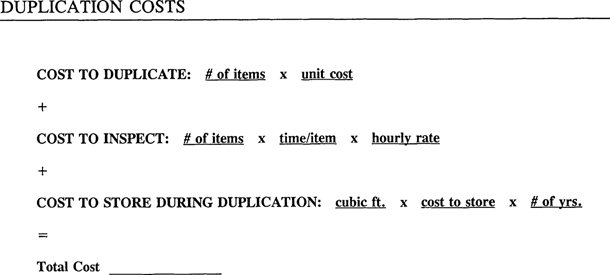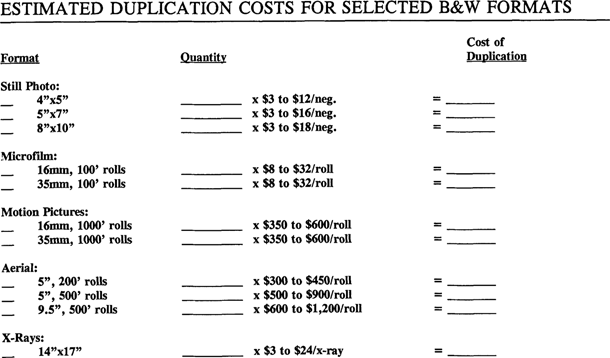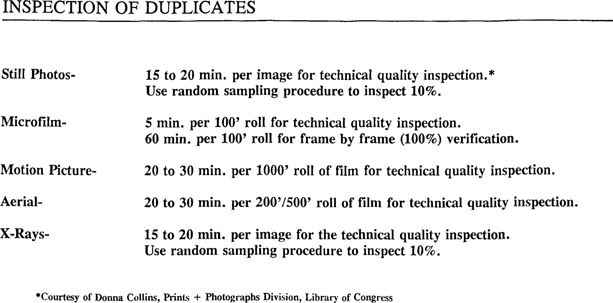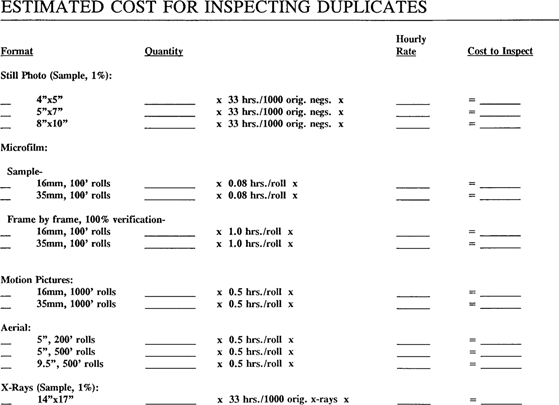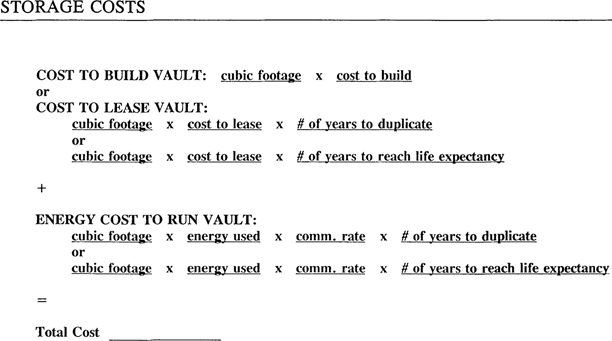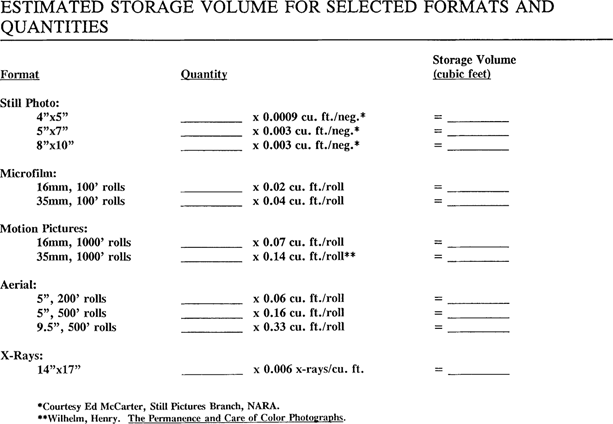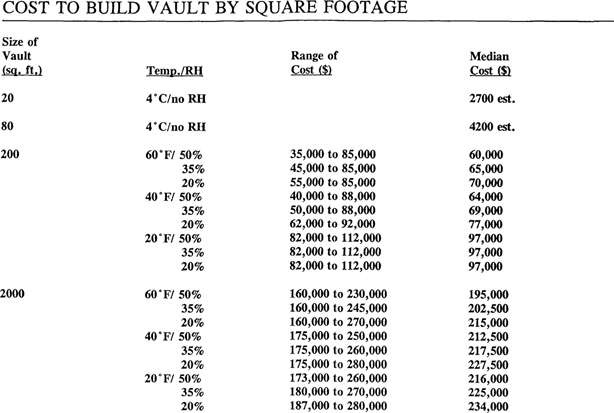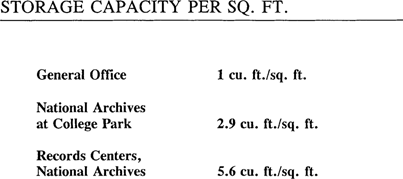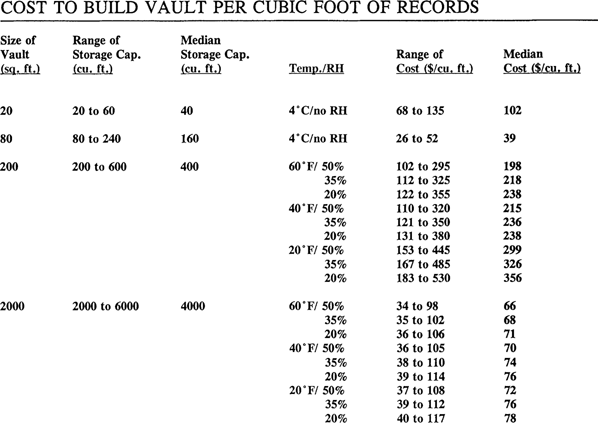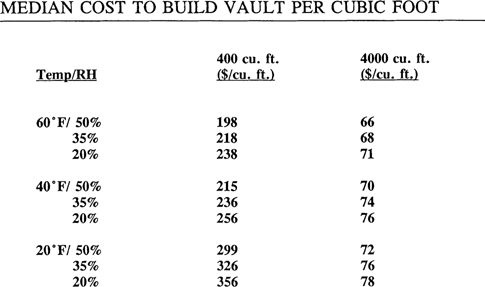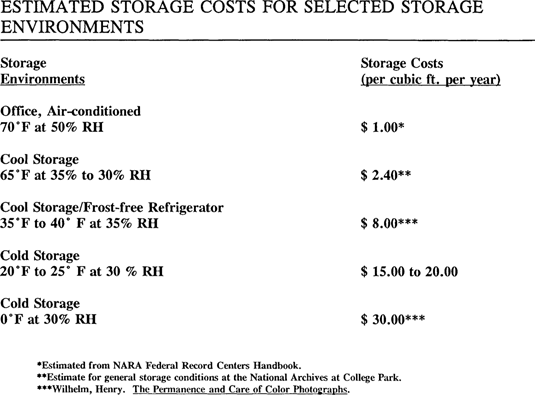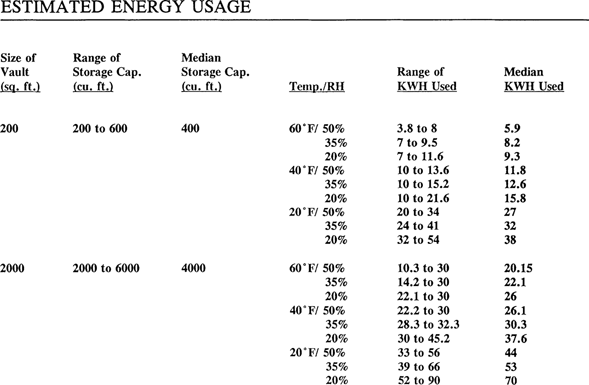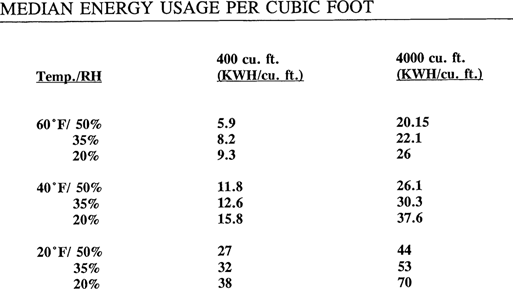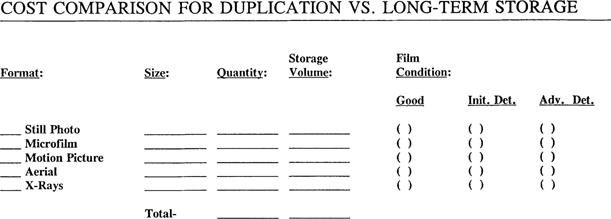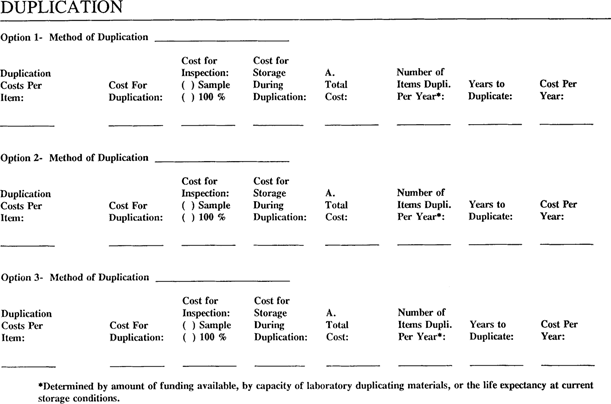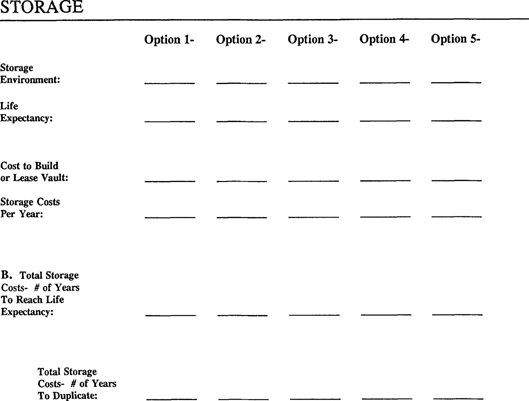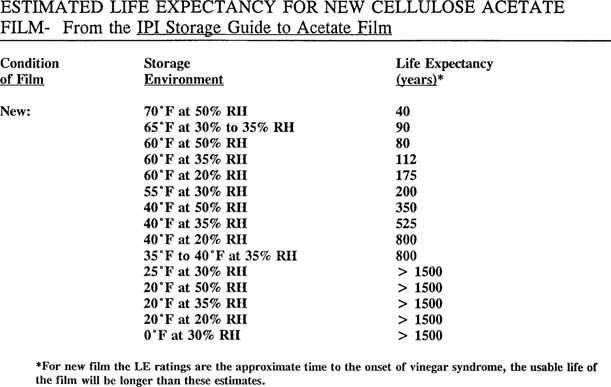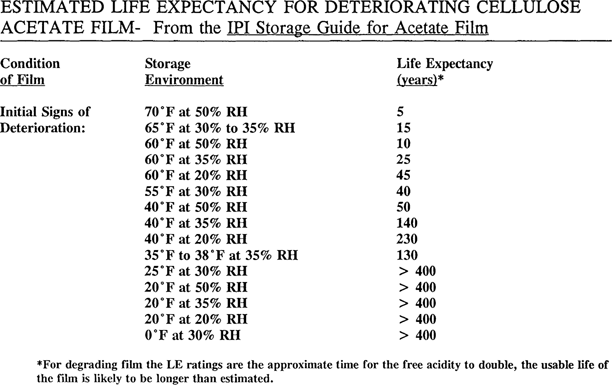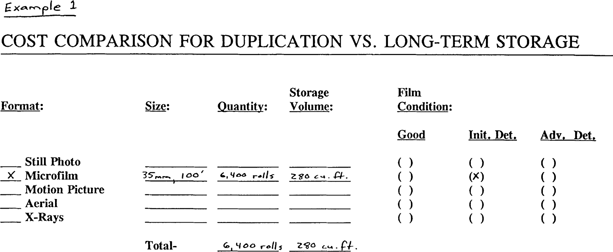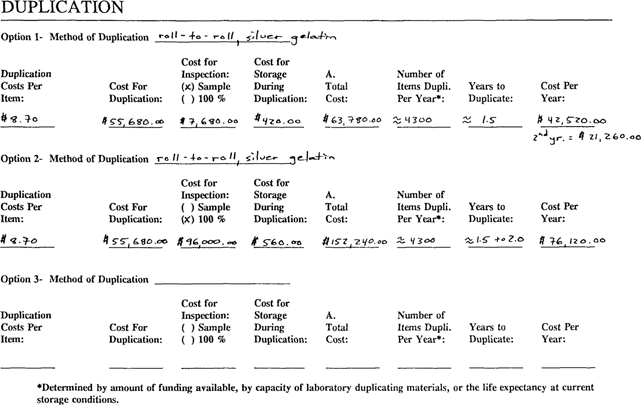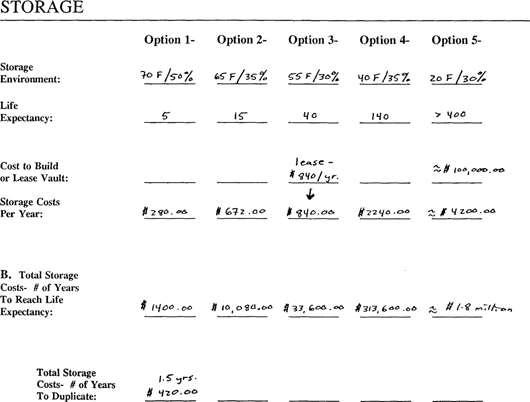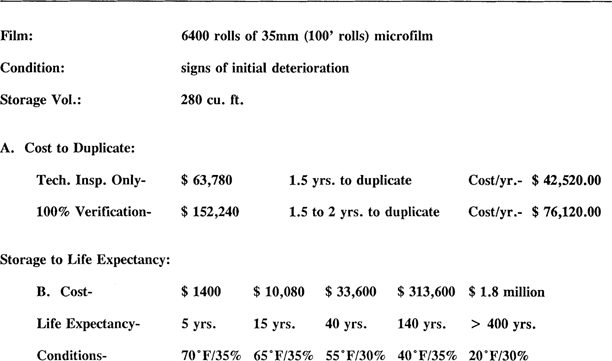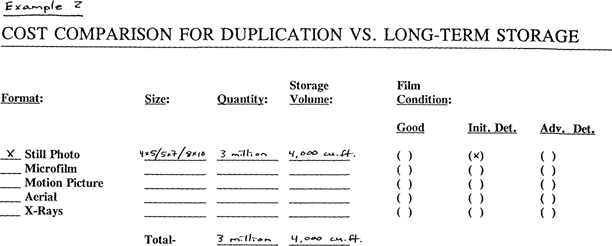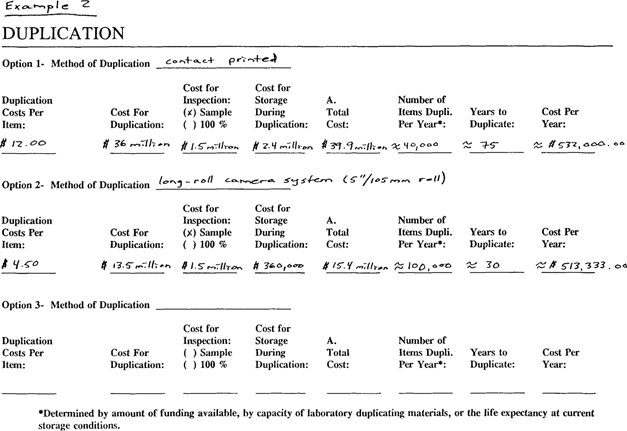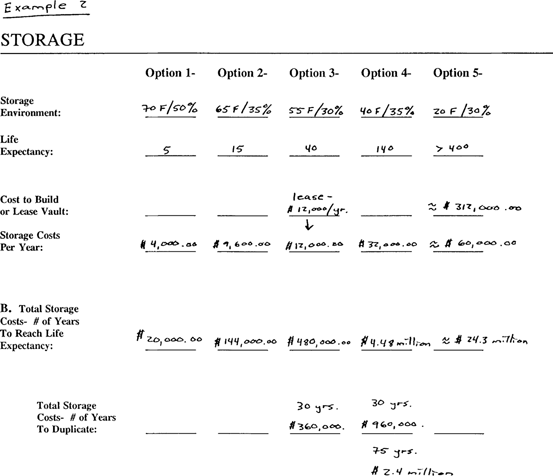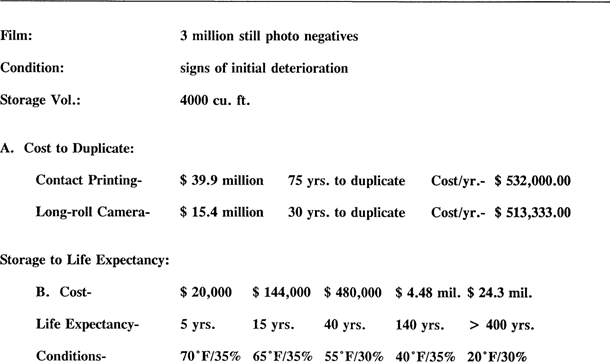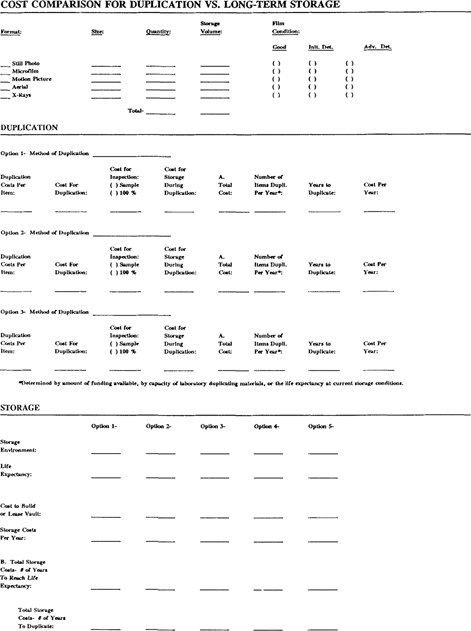
Topics in Photographic Preservation 1995, Volume 6, Article 4 (pp. 50-79)
Institutions should perform a cost-benefit analysis to determine the most cost effective approach or combination of approaches to preserve their holdings or collections of acetate film based photographic materials. Cost-benefit analyses can be conducted for specific collections or for an entire institution. Generally, the preservation of acetate film collections will require an approach that combines the systematic duplication of acetate film materials onto polyester based film with the cool/cold storage of original acetate film materials to extend the usable life. Often for small collections it will be most economical to duplicate the collections, while large acetate film collections will require a combined approach of cool/cold storage and a long-term plan for duplication.
Attached are a series of charts and forms designed to facilitate conducting a cost-benefit analysis. The specific information provided in the charts and derived from the forms is intended to provide basic guidance for deciding how best to approach the preservation of photographic film collections. The intent is to provide a framework that can be used to conduct a cost-benefit analysis comparing duplication with cool/cold storage. The same basic approach to cost-benefit analysis can be applied to other preservation management issues.
The cost to duplicate a collection includes the actual cost to duplicate each item, the cost to inspect the duplicates, and the cost to store the originals while they are being duplicated. The cost to store a collection at a specified set of environmental conditions includes the cost to build or lease a vault at the desired environmental conditions and the energy costs to run the vault at those conditions. The cost-benefit analysis can be used to compare the cost of storage at current environmental conditions to storage at colder temperatures which will provide a longer life expectancy for the film.
Generic duplication and storage costs have been worked up based on price quotations from vendors and are provided for various photographic formats. The cost analyses listed here do not take into account inflation, an inflationary factor should be added to the formula for more accurate estimates. The generic estimates should be used for an initial analysis only, pricing specific to a particular collection or institution should be used for more accurate analyses.
Following the charts and forms are two examples of cost-benefit analyses, one for deteriorating microfilm and one for deteriorating still photo negatives.
The first example is 6400 rolls of 35mm microfilm that show the initial signs of deterioration. The estimated cost to duplicate the 6400 rolls is $63,780 or $152,240, the lower price is if only a simple technical quality inspection is conducted on the rolls of duplicate microfilm and the higher estimate includes a frame by frame verification of every roll of duplicate microfilm. The 6400 rolls could be stored for approximately 40 years (the estimated life expectancy at the following conditions for film in the initial stages of deterioration as cited in the IPI Acetate Film Storage Guide) at 55°F and 30% RH for an estimated cost of $33,600. The estimated life expectancy can be increased to 140 by storing the 6400 rolls at 40$$F and 35% RH for an estimated cost of $313,600. In this example it is probably most practical and economical to duplicate all of the film, the theoretical life expectancy of the new polyester based duplicates is 500 years.
The second example is 3 million still photo negatives, a small percentage of which show the initial signs of deterioration. The estimated cost to duplicate all 3 million negatives by contact printing is $39.9 million and would take approximately 75 years to complete; the estimated price includes $2.4 million to store the originals at conditions that will extend the life expectancy to 75 years in order to complete the project. An alternative approach would be to use a large format, long-roll camera system to duplicate the negatives, the estimated cost would be $15.4 million and it would take approximately 30 years to complete the duplication, this estimated cost includes $360,000 to store the originals while they are being duplicated. Obviously, when a collection is this large, improved storage to extend the usable life of the acetate film negatives is essential to complete the project. The project could be completed in a shorter time, but it would require significantly more money and staff to do this. Storing the film at 55·F and 30% RH will provide an estimated life expectancy of 40 years at an estimated cost of $480,000; storing the film at 40·F and 35% RH will provide an estimated life expectancy of 140 years at an estimated cost of $4.48 million; and storing the film at 20·F and 30% RH will provide an estimated life expectancy of 400 years at an estimated cost of $24.3 million. For this size collection, storage at 40·F and 35% RH for 140 years is significantly less expensive than either duplication option and it could be combined with prioritized duplication of only the actively deteriorating negatives, the negatives that are of high value, and the negatives that are requested frequently.
Duplication is an essential part of any preservation plan for collections of photographic materials. Implement long-term duplication projects using available resources. Usually, resources will be limited and most duplication projects will be long-term. Duplicate only those materials that truly warrant duplication, evaluate collections/holdings and prioritize materials to be duplicated. The selection and planning for duplication should be based on three priorities- duplicate materials of high value, duplicate actively deteriorating materials, and duplicate frequently requested materials. Select the most economical method of duplication that meets all archival/technical requirements, including value of originals, quantity of materials to be duplicated, condition of materials to be duplicated, and the level of use/access required for the materials. Use polyester based duplicating film for all applications, including motion pictures. Polyester based duplicates are important to reduce the need for cool/cold storage. Polyester film is significantly more stable than acetate film, even at higher storage temperatures. Maintenance of a collection on acetate based film will always cost more for storage because of the need for cool/cold storage. When duplicating motion pictures, polyester based preservation masters should be placed in extended term storage and acetate based film may be used for printing masters, projection prints, and editing copies.
Thank you to Sarah Wagner, Photograph Conservator, National Archives, for all the input and editorial assistance. Thank you to Paul Zimmerman, Harris Environmental Systems, to Carl Krotine, Environmental Growth Chamber, to Andy Shelter, Cargocaire Engineering, and to Jill Anderson, Norlake, Inc. for pricing and information on cool/cold storage vaults. Thank you to Anthony Fantozzi, National Archives, to Ed McCarter, National Archives, and to Donna Collins, Library of Congress, for all the information and assistance provided. Thank you to Henry Wilhelm, Wilhelm Imaging Research, and the Image Permanence Institute for all of the information they have published on the stability of photographic materials that was used in creating this cost-benefit analysis system.

